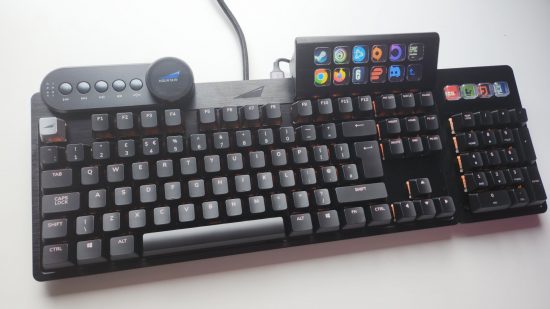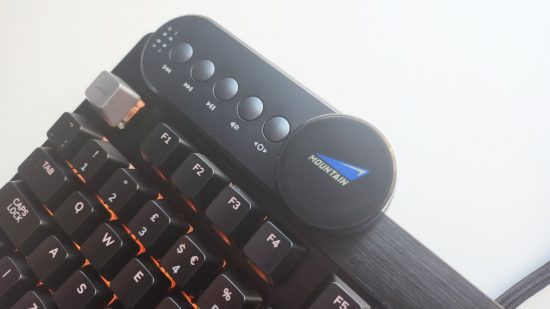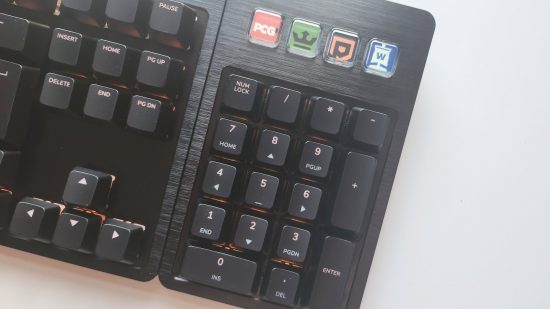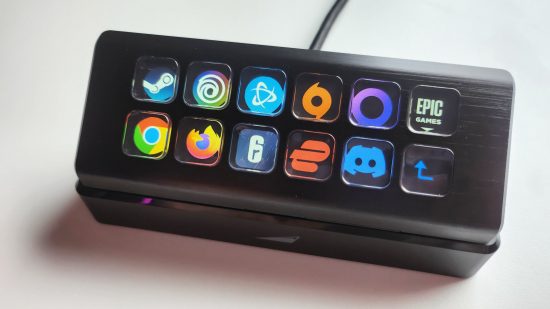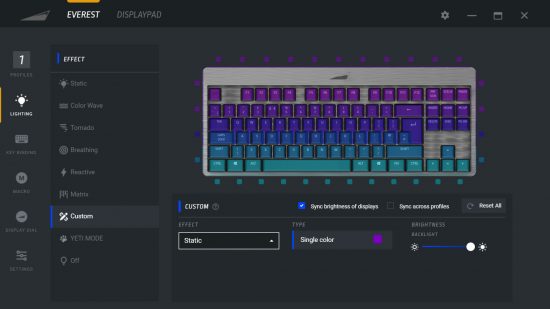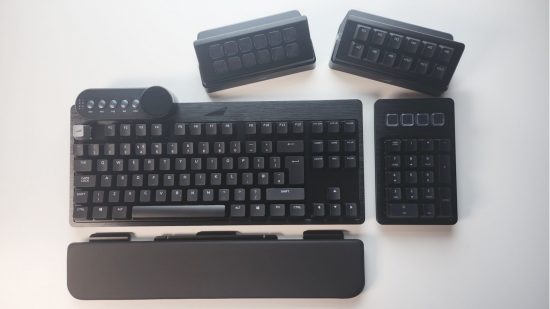Our Verdict
A modular keyboard like no other, packed to the brim with accessories that are nothing short of a Twitch streamer's dream
- Modular
- Hot-swappable switches
- LCD macro buttons
- Wrist rest is a bit thin
- Collectively pricey, but you can buy part-by-part
Diving into the Mountain Everest Max review changed my opinion of what a gaming keyboard should be, standing out from the crowd with an unparalleled level of customisation. The complete package is nothing short of a Twitch streamer’s dream, baking elements of the Elgato Stream Deck into its DNA. The best part, however, is that while the Everest Max sits at the peak of the Mountain range, its modularity creates an increasingly affordable pathway for those that find the full whack a bit too pricey.
Mountain goes a long way to convince you that the Everest Max is the best gaming keyboard out there, with a quality that makes you forget that the device itself was born in the fiery pits of crowdfunding. Unboxing it is treated as a red carpet event, with magnetic latches, a cabinet’s worth of draws for its accessories, and packaging you won’t want to throw out.
Looking at its individual features, little of what the Mountain Everest Max does is new. We’ve already seen plenty of keyboards with hot-swappable mechanical switches, some with a detachable screen, and others with a numpad you can chuck to the left. This is the first time we’ve collectively seen them all in one device, though, as the Everest Max perfects the Swiss Army knife approach.
Pros
- Modular
- Hot-swappable switches
- LCD macro buttons
Cons
- Wrist rest is a bit thin
- Collectively pricey, but you can buy part-by-part
Design & features
With most keyboards, you’re stuck with what you’ve got unless you replace the entire thing, but that’s not the case with the Everest. If you can’t afford it all in one lump sum, you have the freedom to start smaller and build your way up until you’re kitted out with everything you want. As its name suggests, the Everest Max comes with all the trimmings for $249.99 USD / £249.99 GBP. If you fancy shaving some of that cost down, you can instead grab either the Everest Core Barebones (a tenkeyless shell without mechanical switches) for $129.99 / £129.99 or the Everest Core (a TKL model) for $149.99 / £149.99, and add the accessories later down the line.
| Mountain Everest Max specs | |
| Number of keys | Full-size with 104 keys, four display keys |
|---|---|
| Switches | Swappable, Cherry MX or Mountain pre-installed |
| Connectivity | Wired |
| Media keys | Dedicated via attachment |
Our test model has a black milled aluminium finish and Cherry MX Brown switches in the UK ISO layout. This is one of several configurations you can choose from, with a gunmetal grey option, ten different regional layouts, and five Cherry mechanical switches to piece together your ideal build. Mountain’s very own Blue Tactile 55 switches impressed us in our Mountain Everest 60 review, so it’s a shame not to see them come as part of the package, but you can always grab a set separately as they’re hot-swappable with three-pin switches.
Mountain includes a confusing swarm of USB ports, but disappointingly only the single Type-A is a passthrough you can use however you’d like. The two USB-C ports on the rear only work with the media dock, the two either side of the keyboard strictly work with the detachable numpad, and the one underneath feeds the power. The routing system on the underside is one of the best I’ve seen, going a long way to help you manage cables so you don’t end up with a spaghetti situation in your PC setup.
RGB lighting is uniform between the Everest and its numpad, not only shining per key but also accentuated with a strip around the edge. You’ll need to turn up the brightness in the Base Camp software to get the most out of it since it’s dimmed by default, but the colours are vivid and pop through the ABS keycaps.
The numpad goes a step further than any we’ve seen before, as Mountain places four LCD buttons across the top. They’re not as spongy as the Elgato Stream Deck, but work much in the same way with functions and icons you can customise in the Base Camp software. This feature alone is worth getting the Everest Max for.
Performance
Mountain includes a layer of sound-dampening foam, which makes typing on the Everest Max a pleasant experience. I don’t find its pronounced click quite as satisfying as the Everest 60 with the same switches, but acoustics are a personal preference and depend on several factors in your PC setup. Regardless, it’s among the best Cherry MX-laden boards and doesn’t disappoint.
As an original backer of the Kickstarter campaign, the Everest Max has been my go-to keyboard since it was released in 2020, and the one I keep returning to in between reviews. Its magnetic memory foam wrist rest isn’t quite as plush as others I’ve used from Razer and Asus, but it’s comfortable. I’m less of a fan of the Everest forgoing flip-out feet in favour of magnetic discs, though, as while they offer more stages for a more incremental incline compared to the usual two-step, they’re easy to lose and less than ideal for travelling.
The media dock isn’t just a convenient attachment that gives you playback shortcuts, as its IPS display is a ton of fun to play with. It tells the time, monitors your hardware, and yes, you can customise the background with pretty much anything – like a shameless promotion of the PCGamesN logo. It’s a whole lot more functional the Mad Catz Strike 7 was back in the day and doesn’t carry the same premium as the Corsair iCUE Nexus, but you’re stuck with the built-in options since it doesn’t have the same modding community as the Logitech G15.
I’ve long advocated for plonking the numpad on the left-hand side for more mouse space, but the quadruple LCD keys drive the point home since it makes them easier to reach. They’re best suited in the hands of streamers with Twitch and OBS integrations, but the buttons also make shortcuts and launching your favourite games that much easier.
DisplayPad and MacroPad (optional)
If the four buttons on the numpad aren’t enough or you’re not sold on buying the full keyboard, then the DisplayPad and MacroPad are probably more your stride. These keypads aren’t included in the Everest Max bundle and they’ll work with absolutely any setup, even if you don’t own Mountain products. There’s a small benefit to pairing them with an Everest, though.
The DisplayPad is a standalone 12 key model for $109.99 USD / £99.99 GBP, which is cheaper than the Elgato Stream Deck for near-identical features. The buttons have a firm click and, much like the Everest Max numpad, don’t feature any key wobble – which I personally prefer.
The MacroPad strips the cost down to $59.99 USD / £49.99 GBP with 12 screenless mechanical keys. By default, it comes with Mountain’s blue Tactile 55 switches, but these are hot-swappable and let you replace them if you’re not a fan.
Since these are standalone products, they’ll take up a USB slot of their own. Both come with a robust stand you can place anywhere around your keyboard, but trust me, it won’t budge an inch accidentally when you’re pushing buttons. It’s made of metal with a rubberised base, so they stay put until you lift and intentionally reposition them.
You can do away with the stand entirely if you own an Everest, though, slotting it onto the back of the keyboard in the same way as the media dock. You can even plug it in using the USB Type-A passthrough to cut down on the amount of wires reaching across your desk, although the default cable it a little too long to pull this off without looking a bit messy. I opted for a separate, shorter cable to pull this off.
Regardless of which you opt for, they’re easy and intuitive to use in the Base Camp software. You can drag-and-drop functions when assigning what each key does. The only minor issue I’ve experienced with it is when switching back and forth between separate profiles using the DisplayPad. It switches to the second profile instantly, but swapping back to the first profile again is noticeably slower. It’s not too much of an inconvenience and it could get better with future updates, but might be a problem for those wanting to use more than 12 functions.
Software
The Base Camp software has come a long way since it first released, chock full of options in a stylish package. Here, you can set up macros and different keybindings, customise what’s on the display dial and LCD buttons, sift through the settings, personalise the RGB lighting, and create up to five different profiles. Five profiles might not seem like much, and it still lacks game detection to automatically swap between what you’re playing, but these profiles are stored on-board so you’re less reliant on the software being active.
I still take issue with the name, as the mountaineering theme doesn’t mean it’s easy to remember if you don’t pin it to your taskbar or desktop. I personally use the Windows Start Menu to open programs, but Base Camp doesn’t appear when typing in ‘Mountain’. It unnecessarily increases the learning curve until the name sticks in your mind, which is particularly annoying when your setup probably consists of products from several companies, each with their own program. The software also isn’t available for macOS or Linux, meaning it isn’t the best to pair with a Steam Deck unless you’ve installed Windows.
Fortunately, Base Camp is pretty robust for a relative newcomer, and has ironed out most of its issues. It no longer crashes like it once did and is zippy to make changes in real time. When you select different Mountain devices, the corresponding product flashes so you’re aware of what you’re customising, which is a neat touch.
Verdict
At $249.99 USD / £249.99 GBP, the Mountain Everest Max is a big investment, but it packs enough value that you could consider it a steal. The only features it’s missing are optical keys and a wireless connection, which might give the Asus ROG Claymore II the edge. Unlike its competitor, however, the Everest lets you pay your way for the features you specifically want.
For the brand’s first-ever keyboard, and a Kickstarter project no less, the Everest Max is a home run. Mountain is also quickly learning what its customers want, introducing its own switches, a fantastic 60% keyboard, and several handy accessories. So very rarely has a new company excited me the way that Mountain does, and I can’t wait to see what comes next.
The standalone DisplayPad and MacroPad live up to the same high bar the Everest Max sets, with a fantastic build and lean price. Elgato has stiff competition if it wants to hold onto its crown.
